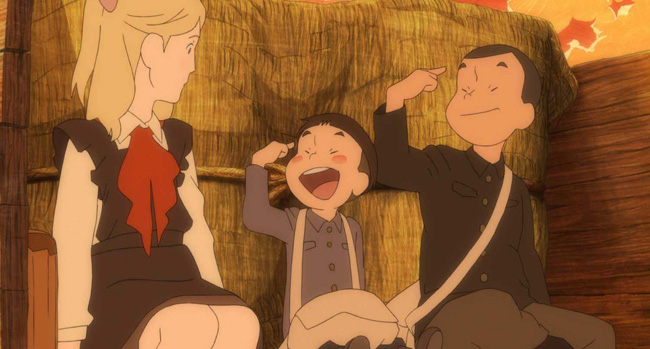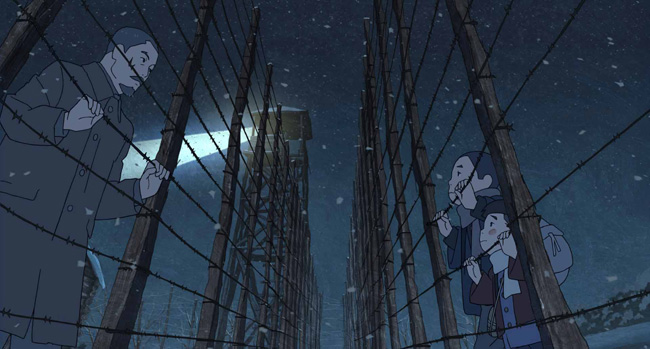
Written by Shigemichi Sugita and Yoshiki Sakurai
Directed by Mizuho Nishikubo
Japan, 2014
In its frequently sorrowful tale of young Japanese siblings struggling through the tail end or immediate aftermath of World War II, anime Giovanni’s Island faces seemingly inevitable comparisons to both Grave of the Fireflies and the Barefoot Gen features. Mizuho Nishikubo’s film, however, has a spirit all of its own, even if you can trace in it bits of those other films’ DNA, as well as notorious British anti-war animation When the Wind Blows, whose art style it resembles more than the likes of Studio Ghibli. It stands apart in offering a look at an aspect of Japanese history rarely explored in any art form to date, that of the Russian occupation of the island of Shikotan after Japan’s defeat in 1945, as seen through the eyes of two Japanese children among the residents whose lives are upended by the new rule.
While the adults in their lives, including their widowed father, their reckless uncle and a teacher turned mother figure, plot various ways of bypassing the restrictions placed on the Japanese residents, Junpei and Kanta form a friendship with a Russian girl and her family who now occupy what was their house, with the Japanese family now relegated to dwelling in their former barn house next door. The girl, Tanya, is the daughter of the Soviet commander for the island, and a blossoming relationship develops between her and Junpei, the older of the two brothers. This stretch of the film is more optimistic, as it shows a story of Japanese and Russian children becoming close despite the ever-present threat of conflict regarding the adults, though there is a lot of bite in small moments, particularly in regards to cultural assimilation. A classroom of kids laugh at the idea of the Russian class next door learning Japanese, but go dead silent when Junpei, in attempting to make a joke, proposes the Shikotan residents learning Russian as similarly preposterous. Naturally, the Japanese children do pick up some Russian, but in one touching sequence the Russian youths demonstrate a willingness to absorb the culture of those who were on the island first.
Events eventually take a more serious turn, though, and the island’s already frail stability takes a major hit. From then, the film successfully detours from a somewhat more innocent though still wistful tone to a more harsh depiction of the brutal realities of the extended occupation. The family is torn apart from both their home and each other, with only the memory of a story their father shared keeping the boys’ optimism alive during their harrowing journey.
That story their father shared is the classic Japanese novel Night on the Galactic Railroad by Kenji Miyazawa, quotes from which open Giovanni’s Island and are scattered throughout the narrative; one quote – “grant that my body be used for the true welfare of all” – is used in an especially powerful fashion as one adult character is taken away from the kids. That fantasy story of a magical train that travels through the stars also imbues a series of dream sequences throughout Nishikubo’s film, while Junpei and Kanta take on the more European names of Miyazawa’s characters in their interactions with Tanya, Giovanni being the name of Galactic Railroad’s protagonist.
The fantasy sequences are the film’s most overtly stylised moments, but what particularly impresses about the film’s construction is its understated simplicity in many regards, even with some big moments of sentiment here and there. Though it does have narration, it’s not relied on quite so heavily as one what might expect from a normal coming-of-age story, with Nishikubo embedding many key details for understanding the story and characters into the animation choices, such as through subtle, steady changes in colour schemes and background motifs to indicate the change in political atmosphere on the island; the film goes from bouncy, sunny orange in its 1945 opening to icy blue for its final stretches. A layered, moving film of both heartbreak and hope, Giovanni’s Island is one of the best recent wartime dramas, animated or otherwise.
— Josh Slater-Williams
Visit the official website of the BFI London Film Festival.



